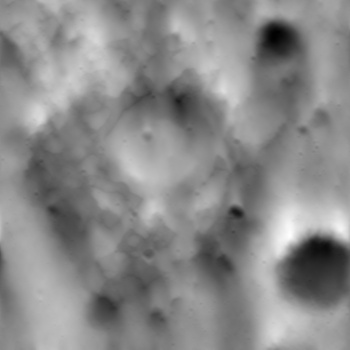I'm replying here to James Ficannon's post in the Apollo from LRO thread. He linked to an image of a very unusual object in images of the floor of Paracelsus C on the far side.
------------------
James:
By the way, any opinion of this blocky thing in Paracelsus C others have found? Simplified link to QuickMap.
http://bit.ly/2ljHDYTMaybe it is just a blocky thing, but I would like it if there were a lot more blocky things in the area which there are not.
--------------------
Me:
That has to be one of the most puzzling things I have ever seen on the Moon. I looked at it with morning and afternoon illumination, and with the Sun nearly overhead. The shadows on the southern object hardly seem to make sense at all, and the northern one is not much better. No idea what it is. Some 3D modelling from stereo images would be useful... I see some of that has been done already, but I am not sure the shadows work with the suggested shape. I will keep thinking about it.
Phil
--------------------
Now I have had some time to think about it. I have a geometric interpretation of the southern object which makes sense to me:
Click to view attachment(I'm still thinking about the northern object, but ultimately I expect it to be similar).
So, I interpret this thing as a steeply oriented thin rock slab. Just using the Quickmap scale bar, it seems to be about 50 m long, maybe 20 m high and maybe 4 m thick with an irregular top edge. There is a linear depression next to the object on it south side, probably a sign of a buried chunk of the same type of material. The shadows make sense to me now.
What can it be? It is on a small mound, one of several on the south floor of Paracelsus C at the foot of the southern wall. I would interpret it as a slab of impact melt (we see flows of melt around many other craters), originally on the rim of the crater and probably long buried under ejecta from other craters to protect it for a billion years or so. Then a wall slump brings it to the floor of Paracelsus C. The slump is the source of the mounds on the floor, and was probably caused by shaking associated with a big impact. By chance these long-buried but coherent, massive slabs of melt end up sticking out of the ground. This whiole area has a 'hilly and lineated' appearance resembling similar terrain on Mercury which has been interpreted as caused by seismic shaking from a giant antipodal impact (Imbrium).
A bit ad hoc, but not as ad hoc as an entrance to an alien base. I would also be happier if there were other similar objects nearby. But you can't have everything.
Phil


























